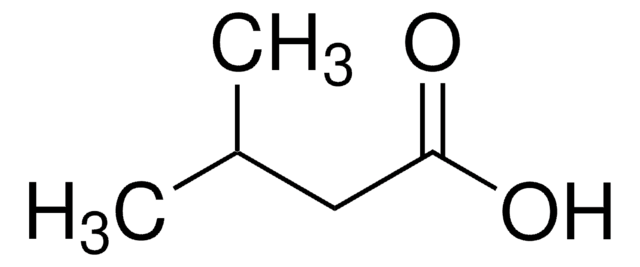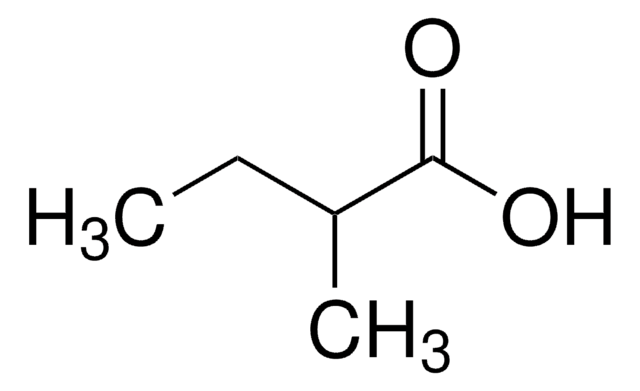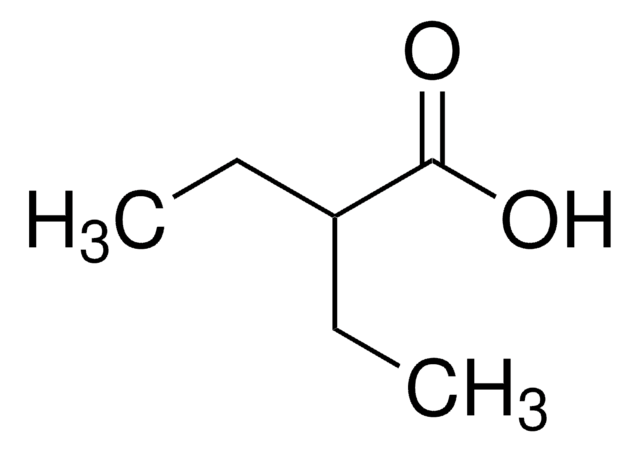About This Item
Produtos recomendados
grau
analytical standard
Nível de qualidade
densidade de vapor
3.04 (vs air)
pressão de vapor
0.43 mmHg ( 20 °C)
Ensaio
≥99.5% (GC)
temperatura de autoignição
824 °F
prazo de validade
limited shelf life, expiry date on the label
Lim. expl.
10 %
técnica(s)
HPLC: suitable
gas chromatography (GC): suitable
índice de refração
n20/D 1.398 (lit.)
p.e.
162 °C (lit.)
pf
−6-−3 °C (lit.)
densidade
0.964 g/mL at 25 °C (lit.)
aplicação(ões)
cleaning products
cosmetics
flavors and fragrances
food and beverages
personal care
Formato
neat
cadeia de caracteres SMILES
CCCC(O)=O
InChI
1S/C4H8O2/c1-2-3-4(5)6/h2-3H2,1H3,(H,5,6)
chave InChI
FERIUCNNQQJTOY-UHFFFAOYSA-N
Procurando produtos similares? Visita Guia de comparação de produtos
Categorias relacionadas
Descrição geral
Aplicação
- Development and validation of a high-performance liquid chromatographic (HPLC) method combined with UV detection to determine four short-chain fatty acids— formic acid, acetic acid, propionic acid, and butyric acid, and lactic acid in bacterial culture samples after their liquid-liquid extraction (LLE)
- Simultaneous analysis of 10 volatile and non-volatile organic acids in 18 samples of Korean traditional fermented soybean paste, doenjang, by HPLC combined with refractive index detector and gas chromatography coupled with flame ionization detector (GC-FID)
- Determination of butyric, lactic, acetic, and propionic acids in sour cassava starch waste-water samples by reversed-phase high-performance liquid chromatography (HPLC) and capillary electrophoresis (CE), both coupled with diode array detection (DAD)
- Multi-residue analysis of six short-chain fatty acids— acetic acid, propionic acid, butyric acid, isobutyric acid, valeric acid, and isovaleric acid, in biological samples of mice colon content by a gas chromatographic method combined with flame ionization detector (GC-FID)
- Packed-fiber solid phase extraction (PFSPE) of eight short-chain fatty acids using polypyrrole nanofibers, from urine samples of children for quantification by gas chromatography-mass spectrometry (GC-MS)
- Multi-residue analysis of 76 volatile compounds from jujube extract samples by gas chromatography-mass spectrometry (GC-MS) after their extraction by steam distillation combined with drop-by-drop extraction
Outras notas
Produtos recomendados
Palavra indicadora
Danger
Frases de perigo
Declarações de precaução
Classificações de perigo
Acute Tox. 4 Oral - Eye Dam. 1 - Skin Corr. 1B - STOT SE 3
Órgãos-alvo
Respiratory system
Código de classe de armazenamento
8A - Combustible corrosive hazardous materials
Classe de risco de água (WGK)
WGK 1
Ponto de fulgor (°F)
161.6 °F - closed cup
Ponto de fulgor (°C)
72 °C - closed cup
Equipamento de proteção individual
Faceshields, Gloves, Goggles, type ABEK (EN14387) respirator filter
Escolha uma das versões mais recentes:
Já possui este produto?
Encontre a documentação dos produtos que você adquiriu recentemente na biblioteca de documentos.
Os clientes também visualizaram
Artigos
Separation of Propionic acid; Acetic acid; Heptanoic acid; Isobutyric acid; Valeric acid; Isocaproic acid; Butyric acid; Isovaleric acid
Separation of Methyl oleate; Caprylic acid; Heptanoic acid; Methyl decanoate; Methyl dodecanoate; Myristic acid; Methyl palmitate; Methyl palmitoleate; Methyl stearate; Methyl linoleate; Methyl linolenate; Acetic acid; Arachidic acid; Behenic acid; Propionic acid; Isobutyric acid; Valeric acid; Isovaleric acid; Isocaproic acid; Butyric acid
Protocolos
In this study, SPME was used for the analysis of free fatty acids in Parmesan cheese using a 65 μm Carbowax/divinylbenzene (DVB) SPME fiber. Headspace extraction of the cheese sample was conducted at 65 °C for 15 minutes and analyzed by GC with FID detection. SPME is ideal for analyzing the volatiles associated with solid food samples. The phase chemistry of the Nukol GC column provides excellent peak shape of acidic compounds.
Separation of Acetone; Acetic acid; Propionic acid; Ethyl butyrate; Ethanol; Isoamyl acetate; Isobutyric acid; 3-Methyl-2-butanol; Methyl acetate; 1-Propanol; Acetal, ≥98%, FG; 2-Methyl-1-pentanol; Butyl acetate; Ethyl propionate; 3-Pentanol; 2-Pentanol, 98%; Ethyl isobutyrate; Isobutyl acetate; Acetaldehyde; Furfural; Butyric acid; Methanol; Ethyl acetate
Nossa equipe de cientistas tem experiência em todas as áreas de pesquisa, incluindo Life Sciences, ciência de materiais, síntese química, cromatografia, química analítica e muitas outras.
Entre em contato com a assistência técnica









